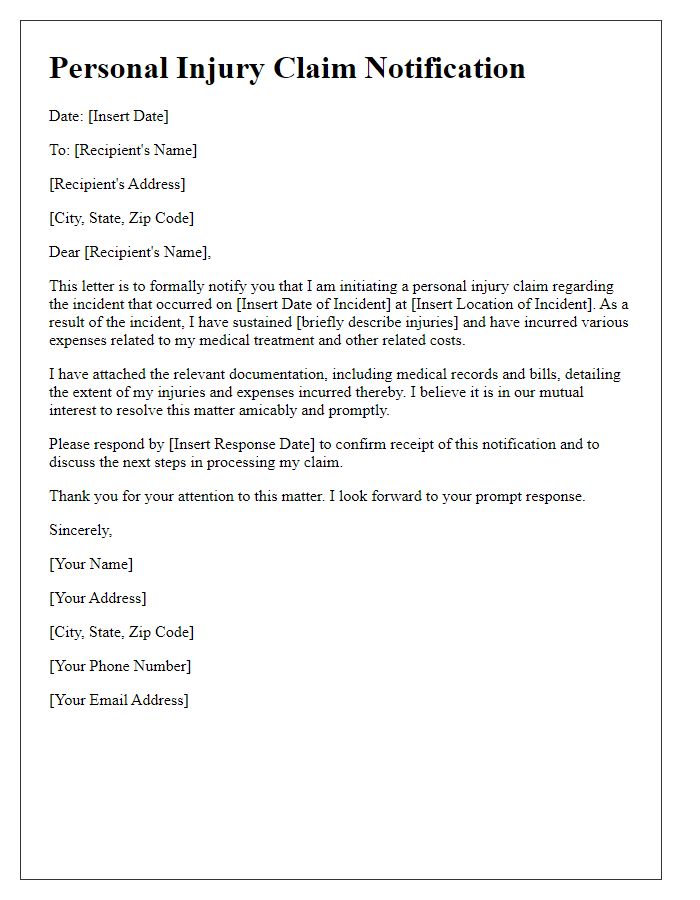Are you navigating the daunting process of initiating a personal injury claim? It can feel overwhelming, but taking the first step is crucial for securing the compensation you deserve. In this article, we'll explore essential components of a personal injury claim letter, ensuring you communicate your needs clearly and effectively. Ready to learn how to craft the perfect letter? Let's dive in!

Recipient's Contact Information
Personal injury claims often begin with clear communication from the injured party. Details such as the recipient's contact information are critical in formalizing the initiation process. Key elements involve the recipient's name, address, city, state, and zip code, ensuring proper identification of the involved insurance company or responsible party. Additionally, including a phone number and email address enhances the ability to facilitate further correspondence. This structured approach maintains clarity and opens the door for negotiations or settlement discussions related to the injury incident.
Claimant's Personal Details
When initiating a personal injury claim, it is crucial to provide comprehensive details about the claimant. Full name, as listed on legal documents, must be included to establish identity. Residential address (including street number, city, state, and zip code) ensures proper correspondence and verification of residence. Date of birth, typically formatted as MM/DD/YYYY, helps to ascertain age and potential eligibility for damages. Additionally, phone number (both mobile and home) and email address facilitate direct communication regarding the claim. Lastly, social security number, while sensitive, is often required for identity verification and to expedite the claims process, ensuring all personal and financial aspects are correctly aligned.
Date of Injury and Incident Description
The date of injury, often critical for personal injury claims, typically refers to the specific day when the accident or incident occurred, which directly caused harm to the individual. For instance, an injury sustained on March 15, 2023, at a busy intersection in downtown Chicago may involve details such as a vehicular collision due to a negligent driver. Incident description should include specific factors like weather conditions (e.g., raining), the time of day (e.g., 7:30 PM), and external influences (e.g., inadequate street lighting), providing clarity on the circumstances surrounding the event. This comprehensive account aids in establishing a timeline and context, crucial for legal proceedings.
Medical Treatment and Expenses Summary
Personal injury claims often require a comprehensive summary of medical treatment and expenses incurred due to the incident. Accurate documentation of expenses is crucial for a successful claim. Medical treatment can include various services, like emergency room visits, surgeries, physical therapy, and prescription medications. For instance, an emergency room visit may incur costs around $1,500, while outpatient physical therapy sessions could add up to $100 each. Prescription medications for pain relief might total $300, depending on dosage and duration. Detailed records of these expenses, alongside medical bills and treatment dates, will strengthen the claim's validity. This summary must effectively illustrate the financial impact of the injury, demonstrating how medical treatment directly relates to the incident. Legal representation often requires this summary to negotiate settlements with insurance companies or during litigation.
Demand for Compensation and Supporting Documents
A personal injury claim initiation requires a detailed demand for compensation along with supporting documents. The claim should include essential details about the injury event, such as the date (for instance, March 15, 2023), location (specific address or venue), and circumstances (car accident, slip and fall) that led to the injury. Documentation to support the claim must be appended, including medical records (hospital visit notes, treatment plans), accident reports (police or incident reports), and photographs (of injuries, accident scene) that clearly depict the extent of damages. Additionally, evidence of lost wages (pay stubs, employer statements) and testimonies (witness statements) can bolster the compensation request. The total compensation sought should reflect all incurred expenses and losses, providing a comprehensive overview of the financial impact of the injury.













Comments